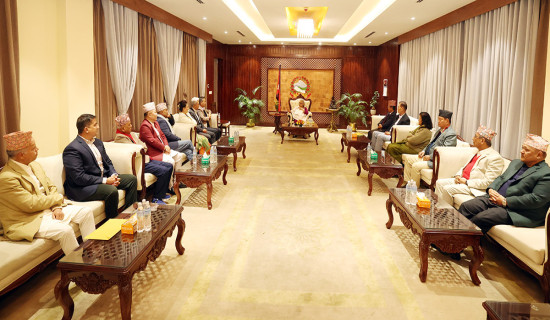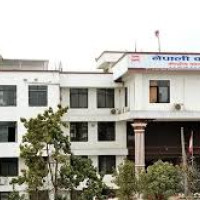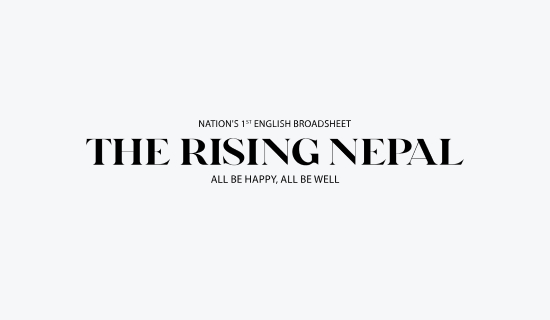- Sunday, 30 November 2025
Occupational Medicine Protects Workers
Occupational medicine is a medical specialty focused on preventing, diagnosing, and managing work-related illnesses and injuries. It promotes workers’ health by addressing physical, mental, ergonomic, and industrial hazards. Physicians in this field assess fitness for duty, oversee health surveillance, manage return-to-work plans, and guide employers in maintaining a healthy workforce. Occupational medicine is a clinical branch of the broader field of occupational health and safety (OHS). OHS involves multidisciplinary professionals, safety officers, engineers, and public health experts who design safe systems and enforce regulations. In essence, occupational medicine targets individual health, whereas OHS fosters a safe work environment.
Every day, over 2,500 Nepalis migrate abroad for employment, mainly to the Middle East, Malaysia and East Asian nations, while other millions move informally to India. Over 2 million work in the Gulf and Malaysia, with another 2.5 to 5 million estimated in India. However, this remains untraceable mainly because of unrestricted cross-border mobility. In June 2024, the International Organisation for Migration unveiled that migrant workers sent home USD 11 billion in remittances, accounting for 26 per cent of Nepal’s Gross Domestic Product (GDP). Yet, this economic reliance comes at the cost of worker health and safety. In 2023, 1,346 Nepali migrant workers returned in coffins, many victims of preventable occupational hazards.
Dangerous conditions
These low-skilled workers face dangerous conditions, discrimination, long hours of work, and rights abuse, leading to severe physical and mental health issues. The Sustainability Journal in September 2024 revealed that 46.4 per cent of Nepali migrant workers suffer from problems like musculoskeletal pain, heart disease, hearing, vision and skin problems, and work-related injuries. The study in the Journal of BPKIHS in August 2020 found that 56 per cent of returnees experience anxiety disorder, 23 per cent depression, 6 per cent suicidal ideation or attempts, and 11 per cent chronic mental illness. One can see the rise in chronic kidney disease (CKD) among returnees from the Gulf, caused by extreme heat (often exceeding 50°C), dehydration, and unhealthy working conditions.
Almost 31 per cent of kidney patients are migrant workers who are under 40 years of age. Nearly 10,000 Nepali workers have died abroad in the past decade, including over 2,100 in Qatar alone. With Saudi Arabia set to host the 2034 FIFA World Cup, a replication of the 2022 tragedy looms large on the scene. The tragedy is not just in the potential loss of life, but it also demonstrates that many of these deaths are utterly preventable. Measures like access to safe drinking water, shaded rest breaks, and heat protection devices could save lives. Still, law enforcement remains weak and underscores a systemic neglect of workers contributing more to the economy than any other sector — foreign aid, investment, tourism and tax contribution.
Occupational medicine can play a transformative role in reversing this neglect. Pre-employment health assessments conducted by trained occupational physicians can help identify medical conditions that may make workers unfit for specific jobs, thereby preventing life-threatening complications abroad. A brief orientation provided by the assessing physician should be mandatory, educating each worker on potential hazards and prevention strategies specific to their roles. Pre-departure, worker-specific preventive manuals would further enhance preparedness and reduce unintended risks. The benefits span beyond individuals: foreign employers benefit from fewer absences and better productivity, and the government saves on long-term healthcare by preventing chronic illness.
Occupational medicine’s value is not limited to outbound workers. Integrating it domestically across sectors, factories, construction, banks, IT offices, etc., can improve employees’ well-being and their performance. Pre-employment health assessments made by occupational physicians, rather than general physicians, help identify common issues like hypertension or musculoskeletal conditions and hidden mental-health stressors, ensuring each worker is fit for their jobs. A 2008 Journal of Occupational and Environmental Medicine review found that health promotion efforts have reduced sickness absence by 22 per cent and improved work ability by 38 per cent.
According to a 2010 Health Affairs meta-analysis by a Harvard researcher, “every dollar invested in workplace wellness yields $3.27 in reduced healthcare costs and $2.73 in absenteeism savings.” Physical and ergonomic initiatives also matter. Fatigue, widespread in workplaces, has increased long-term sickness absence by 35 per cent, according to the Scandinavian Journal of Work, Environment & Health, 2019. These statistics highlight the need for comprehensive, preventative approaches. There is an acute scarcity of occupational medicine specialists in Nepal, leaving a critical gap in addressing work-related health issues. In the absence of formally trained professionals, the burden has fallen on general and internal medicine physicians, who have admirably stepped up, taking on the challenging responsibility of managing occupational health concerns despite limited specialised training to assess complex workplace hazards or provide preventive occupational health interventions. This has led to a reactive, rather than proactive, approach to workers’ health, focusing on treatment after illness or injury, instead of preventing them through structured workplace assessments and targeted interventions.
Positive developments
Nepal has introduced stricter health checks for migrant workers, including comprehensive tests and regulated fees. These reforms aim to curb fabricated medical reports and reduce preventable deaths. If these mandatory health checkups are conducted by trained occupational physicians who evaluate work-related health risks, they could be even more effective. Their specialised approach would ensure that medical screenings are tailored to the specific job roles and environmental exposures workers face, leading to better preventive care and long-term health outcomes.
Occupational medicine is not just a health solution; it’s a moral, economic, and social imperative. A national strategy is vital: train occupational medicine specialists, enforce pre-employment screenings, introduce hazard-specific orientations, and implement reintegration support for returnees. We owe it to the millions of Nepali men and women who sustain our economy at immense personal cost. Occupational medicine is vital to dignity, safety, and justice for Nepal’s workers.
(Dr. Dahal, who holds a PDOM (occupational medicine), is currently working at Gurkha Welfare Trust Nepal (GWTN).

















